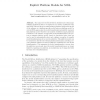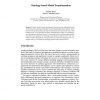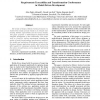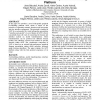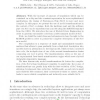UML
2005
Springer
14 years 9 months ago
2005
Springer
The main drive for Model-Driven Architecture is that many software applications have to be deployed on a variety of platforms. The way MDA achieves this is by transforming a platfo...
UML
2005
Springer
14 years 9 months ago
2005
Springer
Today, model-driven development is getting more sophisticated and can be used for modeling enterprises and developing application systems. Since current interoperability solutions ...
UML
2005
Springer
14 years 9 months ago
2005
Springer
This paper presents ATL (ATLAS Transformation Language): a hybrid model transformation language that allows both declarative and imperative constructs to be used in transformation ...
FASE
2005
Springer
14 years 9 months ago
2005
Springer
Model Transformation has become central to most software engineering activities. It refers to the process of modifying a (usually graphical) model for the purpose of analysis (by i...
SAC
2006
ACM
14 years 9 months ago
2006
ACM
Transforming models is a critical activity in Model Driven Engineering (MDE). With the expected adoption of the OMG QVT standard for model transformation language it is anticipate...
ISSRE
2006
IEEE
14 years 9 months ago
2006
IEEE
In a Model-Driven Development context (MDE), model transformations allow memorizing and reusing design know-how, and thus automate parts of the design and refinement steps of a so...
EDOC
2006
IEEE
14 years 9 months ago
2006
IEEE
The variety of design artefacts (models) produced in a model-driven design process results in an intricate relationship between requirements and the various models. This paper pro...
MODELS
2007
Springer
14 years 10 months ago
2007
Springer
In this paper we introduce a novel wide-profile graphical tool-building platform GrTP which is based on the principle of separating semantic domain model processing and user inter...
GTTSE
2007
Springer
14 years 10 months ago
2007
Springer
With the increase of amount of transistors which can be contained on a chip and the constant expectation for more sophisticated applications, the design of Systems-on-Chip (SoC) is...
FASE
2007
Springer
14 years 10 months ago
2007
Springer
Abstract. Software architecture constitutes a promising approach to the development of large-scale distributed systems, but architecture description languages (ADLs) and their asso...
